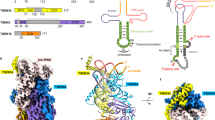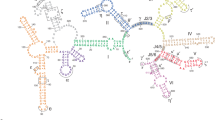Abstract
Splicing is required for the removal of introns from a subset of transfer RNAs in all eukaryotic organisms. The first step of splicing, intron recognition and cleavage, is performed by the tRNA-splicing endonuclease, a tetrameric enzyme composed of the protein subunits Sen54, Sen2, Sen34 and Sen15. It has previously been demonstrated that the active sites for cleavage at the 5′ and 3′ splice sites of precursor tRNA are contained within Sen2 and Sen34, respectively1,2,3. A recent structure of an archaeal endonuclease complexed with a bulge–helix–bulge RNA has led to the unexpected hypothesis that catalysis requires a critical ‘cation-π sandwich’ composed of two arginine residues that serve to position the RNA substrate within the active site4. This motif is derived from a cross-subunit interaction between the two catalytic subunits. Here we test the role of this interaction within the eukaryotic endonuclease and show that catalysis at the 5′ splice site requires the conserved cation-π sandwich derived from the Sen34 subunit in addition to the catalytic triad of Sen2. The catalysis of pre-tRNA by the eukaryotic tRNA-splicing endonuclease therefore requires a previously unrecognized composite active site.



Similar content being viewed by others
References
Abelson, J., Trotta, C. R. & Li, H. tRNA splicing. J. Biol. Chem. 273, 12685–12688 (1998)
Ho, C. K., Rauhut, R., Vijayraghavan, U. & Abelson, J. Accumulation of pre-tRNA splicing ‘2/3’ intermediates in a Saccharomyces cerevisiae mutant. EMBO J. 9, 1245–1252 (1990)
Trotta, C. R. et al. The yeast tRNA splicing endonuclease: a tetrameric enzyme with two active site subunits homologous to the archaeal tRNA endonucleases. Cell 89, 849–858 (1997)
Xue, S., Calvin, K. & Li, H. Structural mechanism of RNA recognition and cleavage by a splicing endonuclease. Science doi:10.1126/science.1126629 (in the press)
Belfort, M. & Weiner, A. Another bridge between kingdoms: tRNA splicing in archaea and eukaryotes. Cell 89, 1003–1006 (1997)
Di Nicola, N. E. et al. The eucaryal tRNA splicing endonuclease recognizes a tripartite set of RNA elements. Cell 89, 859–866 (1997)
Kleman-Leyer, K., Armbruster, D. W. & Daniels, C. J. Properties of H. volcanii tRNA intron endonuclease reveal a relationship between the archaeal and eucaryal tRNA intron processing systems. Cell 89, 839–847 (1997)
Li, H., Trotta, C. R. & Abelson, J. Crystal structure and evolution of a transfer RNA splicing enzyme. Science 280, 279–284 (1998)
Li, H. & Abelson, J. Crystal structure of a dimeric archaeal splicing endonuclease. J. Mol. Biol. 302, 639–648 (2000)
Paushkin, S. V., Patel, M., Furia, B. S., Peltz, S. W. & Trotta, C. R. Identification of a human endonuclease complex reveals a link between tRNA splicing and pre-mRNA 3′ end formation. Cell 117, 311–321 (2004)
Randau, L. et al. The heteromeric Nanoarchaeum equitans splicing endonuclease cleaves noncanonical bulge–helix–bulge motifs of joined tRNA halves. Proc. Natl Acad. Sci. USA 102, 17934–17939 (2005)
Tocchini-Valentini, G. D., Fruscoloni, P. & Tocchini-Valentini, G. P. Coevolution of tRNA intron motifs and tRNA endonuclease architecture in Archaea. Proc. Natl Acad. Sci. USA 102, 15418–15422 (2005)
Bujnicki, J. M. & Rychlewski, L. Prediction of a common fold for all four subunits of the yeast tRNA splicing endonuclease: implications for the evolution of the EndA/Sen family. FEBS Lett. 486, 328–329 (2000)
Lykke-Andersen, J. & Garrett, R. A. RNA-protein interactions of an archaeal homotetrameric splicing endoribonuclease with an exceptional evolutionary history. EMBO J. 16, 6290–6300 (1997)
Reyes, V. M. & Abelson, J. Substrate recognition and splice site determination in yeast tRNA splicing. Cell 55, 719–730 (1988)
Abelson, J. Recognition of tRNA precursors: a role for the intron. Science 255, 1390 (1992)
Baldi, M. I., Mattoccia, E., Bufardeci, E., Fabbri, S. & Tocchini-Valentini, G. P. Participation of the intron in the reaction catalyzed by the Xenopus tRNA splicing endonuclease. Science 255, 1404–1408 (1992)
Lee, M. C. & Knapp, G. Transfer RNA splicing in Saccharomyces cerevisiae. Secondary and tertiary structures of the substrates. J. Biol. Chem. 260, 3108–3115 (1985)
Fruscoloni, P., Baldi, M. I. & Tocchini-Valentini, G. P. Cleavage of non-tRNA substrates by eukaryal tRNA splicing endonucleases. EMBO Rep. 2, 217–221 (2001)
Volta, V. et al. Sen34p depletion blocks tRNA splicing in vivo and delays rRNA processing. Biochem. Biophys. Res. Commun. 337, 89–94 (2005)
Rauhut, R., Green, P. R. & Abelson, J. Yeast tRNA-splicing endonuclease is a heterotrimeric enzyme. J. Biol. Chem. 265, 18180–18184 (1990)
Reyes, V. M. & Abelson, J. A synthetic substrate for tRNA splicing. Anal. Biochem. 166, 90–106 (1987)
Acknowledgements
We thank C. Romfo, A. Jacobson, J. Colacino and D. Glodowski for discussions and critical reading of the manuscript. Author contributions C.R.T. and S.V.P. contributed equally to this work and together with M.P. performed the mutagenesis, purification and testing of endonuclease complexes. C.R.T., H.L., S.V.P and S.W.P. wrote the manuscript together.
Author information
Authors and Affiliations
Corresponding author
Ethics declarations
Competing interests
Reprints and permissions information is available at npg.nature.com/reprintsandpermissions. The authors declare no competing financial interests.
Supplementary information
Supplementary Methods
This file contains additional details of the methods used in this study. (DOC 23 kb)
Rights and permissions
About this article
Cite this article
Trotta, C., Paushkin, S., Patel, M. et al. Cleavage of pre-tRNAs by the splicing endonuclease requires a composite active site. Nature 441, 375–377 (2006). https://doi.org/10.1038/nature04741
Received:
Accepted:
Issue Date:
DOI: https://doi.org/10.1038/nature04741
- Springer Nature Limited
This article is cited by
-
Broadening the phenotype and genotype spectrum of novel mutations in pontocerebellar hypoplasia with a comprehensive molecular literature review
BMC Medical Genomics (2024)
-
Assembly defects of human tRNA splicing endonuclease contribute to impaired pre-tRNA processing in pontocerebellar hypoplasia
Nature Communications (2021)
-
Evolution of the Genetic Code by Incorporation of Amino Acids that Improved or Changed Protein Function
Journal of Molecular Evolution (2013)
-
Diversity and roles of (t)RNA ligases
Cellular and Molecular Life Sciences (2012)
-
Classification, diagnosis and potential mechanisms in Pontocerebellar Hypoplasia
Orphanet Journal of Rare Diseases (2011)





